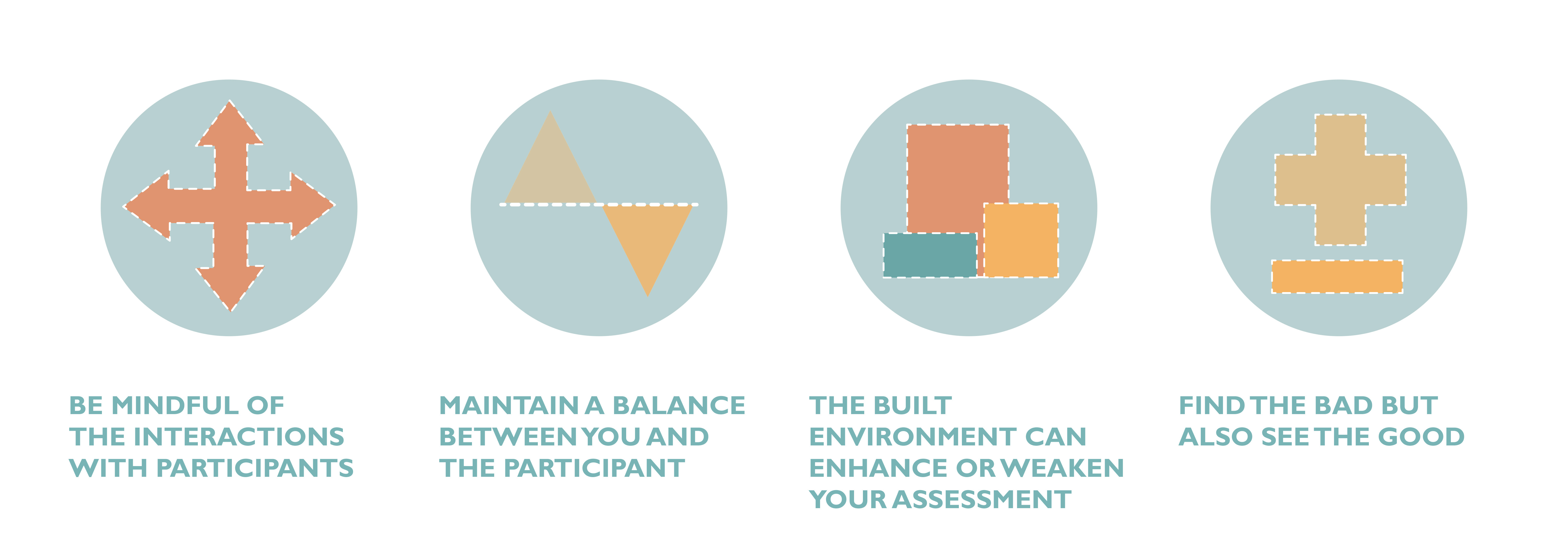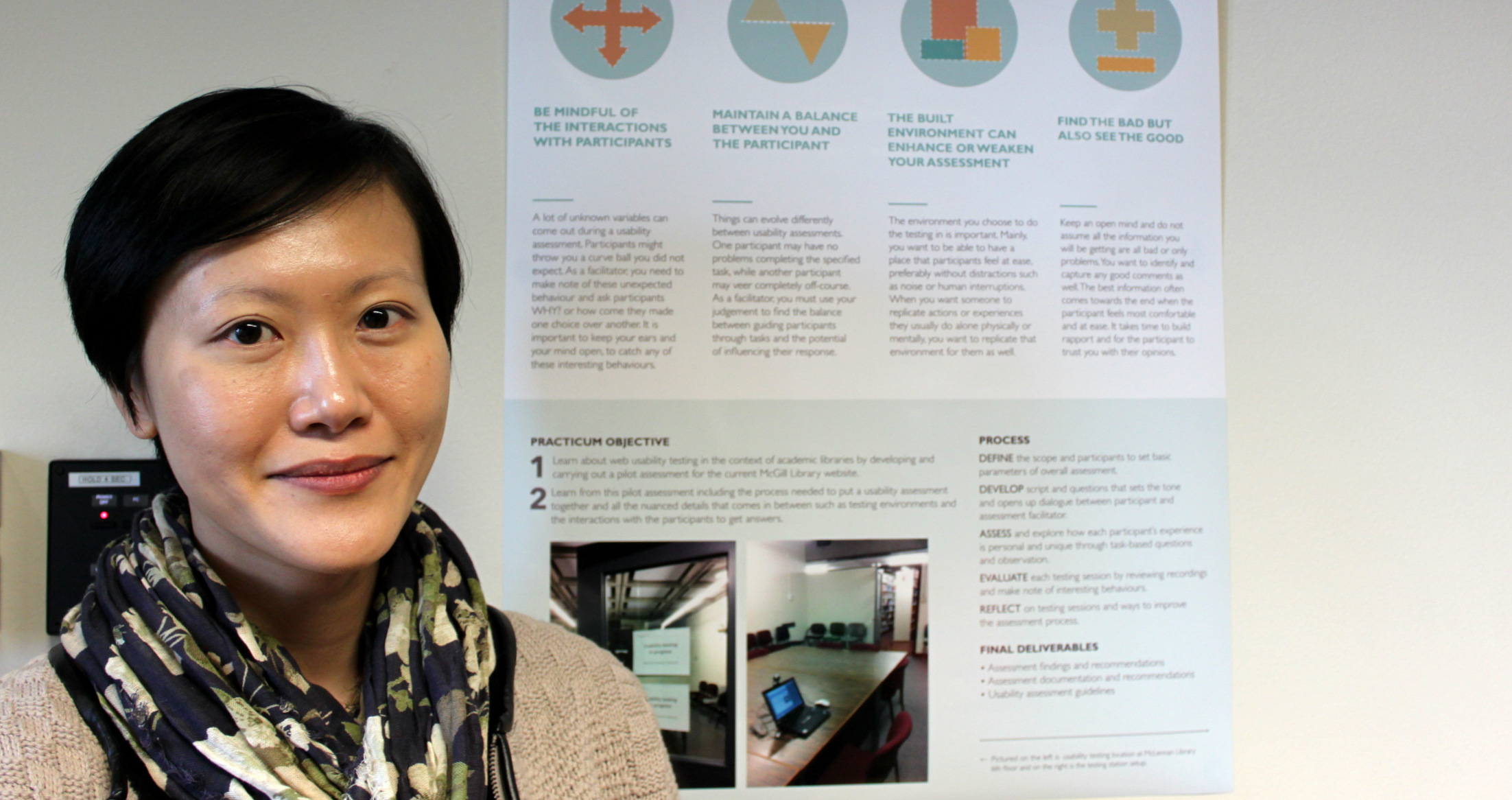During the winter 2014 semester, the McGill Library welcomed 5 practicum students from the McGill School of Information Studies (SIS). The SIS website outlines the practicum experience as
a 3 credit academic elective course in which master’s-level students participate in field practice under the guidance of site supervisors. Students benefit from the opportunity to apply their theoretical knowledge base and learning in a real-world setting, while gaining experience and practicing professional skills. Site supervisors and their workplaces benefit from the energy, knowledge, and skills of an emerging information professional while providing students with a valuable mentorship experience in a real-world setting.
Library Matters took a practicum pause with all five students to talk about their work at the McGill Library and how their experience may help to inform Library units as they move forward with related projects. The third of five interviews features Ada Chan. Ada implemented usability tests and assessment tools to investigate how undergraduate and graduate library users from the McGill community use the library website for their research and learning needs.
LM: Tell us a little about your practicum at the Library.
AC: I worked with the McGill Library on a web usability study, mainly with my supervisor Web Services Librarian Edward Bilodeau. The senior supervisor was Assessment Librarian Lorie Kloda. The project consisted of setting up a pilot usability study to evaluate the current library website. The key objective of the project was to research and evaluate the process involved in web usability testing. During the assessment of the website and the testing process, a lot of questions came up. I asked myself, “How would this process work? As an assessor, how do you catch all the little details such as behaviors and preferences that you wouldn’t normally be able to observe when someone is using the library website?” Even with a script of questions on paper, unexpected behaviors will reveal themselves during testing, and if you miss it, that information is gone. My goal was to understand the process from preparation to implementation and create a guideline of best practices that people can use to carry out future studies.
LM: How long was your particular practicum?
AC: My practicum went from January to April so it lasted about 3-4 months. It was actually very independent. Early on it was only maybe 3-5 hours a week. But I did some readings on my own. Whenever I wasn’t sure how to approach a certain aspect such as number of tests needed or how to talk to participants during testing, I would read up on it. But most of the work actually happened in March during the testing and assessment phase. In January we defined the parameters of the project. In February we did a lot of pre-testing. In other words, we tested the applications, computers, and how the assessment system worked. This was also when we set up the room where participants were going to test the website. At this time, I also had to think about how I was going to approach participants. Then in March, once I sorted out all these details, I started talking to people, invited them to be testers. I had them sit down and work with the website in order to observe them.
LM: How were you able to get people to participate in the study?
AC: McGill Library did a general survey with the community back in the fall of 2013. They posted it on the library home page. A lot of people responded to the survey and at the end of it was a call to action targeted to people who wanted to do more like further testing down the road. About 10 people replied and said yes. So we kept this contact information and reconnected with them for this test.
LM: What kind of questions did you ask participants?
AC: The questions asked were about the home page. We wanted to know how people got from “point A” on the home page to “point B”. I usually asked participants, “How do you access specific or topical databases?” The expert users really didn’t have a problem. They just remember and know exactly where to go, where the links are and how to get to the information they need. It’s the novice users who had the most trouble, or expert users who have really gotten used to the old website. It was frustrating for expert users when they went back to the website and realized what they were used to had changed. It was interesting to interact with these more experienced users. And as the monitor of the assessment, I feel like there is this fine line or fine balance in how I interacted with testers at this time. I had to guide them back out to the right position, but not influence their answers.

Detail from Ada Chan’s practicum poster entitled “How to learn from a library user’s personal unique web experience”.
LM: What skills, lessons or learning moments did you take from this practicum?
AC: The biggest moment for me was learning more about the skills you need when interviewing people. It’s completely different than conversing with people. When you are having a conversation, you are often thinking and doing other things. Events may occur in your immediate surroundings. But when you are trying to interview somebody, your senses are suddenly heightened, especially with usability testing. You try in many respects to be focused and aware. You may very well be trying to physically or mentally put yourself in that person’s shoes and trying to understand what a tester is doing. You are completely focused on one person during an interview along with the task and the questions you were set to find out. Throughout the process, especially at the beginning, I started to realize that being too focused might not be a good thing. I was confined by the questions I set out and missed out on unexpected or new information. I’ve learned that the questions you set shouldn’t completely dictate the testing. They should act as guidelines. I also learned that during usability testing, sometimes you can’t just expect bad things to come out, there are good things, and you have to know how to catch them and when to ask why.
LM: What do you wish you had known before you started the practicum?
AC: I should have done more pre-testing and done 6 rather than 2 pre-tests. If you don’t really have the background or you’ve never done usability testings before, you don’t really know how the environment can affect you, or how your interaction with the person you’re interviewing can lead to answers and a whole new set of questions. The literature I’ve read said two pre-tests were enough. So I did two, two pre-testings with paper and pen, and then two pre-testings with the actual equipment. These pre-tests helped me see how proper equipment can help in the process and how the test questions can improve. But when I held the first two actual assessments I started to realize that they should’ve been considered a pre-test. These two could have helped me better grasp the new variables that can arise during the interactions.
LM: What new discovery did you uncover during this practicum?
AC: I had this expectation when I first started because the literature I’ve read said after interviewing may be three or four people, the kind of interactions that would come up will start to repeat. That means most people will have the same route of access or use the same links. This didn’t happen. It could be because the website is so vast, and there are so many different links and so many different options to get to one place, and everybody has their own unique way to get to a database or journal. And there’s never one way.
It’s kind of like back in Roman times when they built the Coliseum – there was a reason why they had multiple exits, multiple entrances – to accommodate all kinds of people. Maybe it’s the same way in the virtual world.
LM: Is there a moment that stood out for you?
AC: When I bumped into some really good participants who were willing to reveal a lot more than what I had expected. Those sessions were not just asking participants questions but we had real discussions and sharing ideas on how the website could improve. That was the best part of it.
LM: Can you tell us a little bit about where you’ve come from in terms of your education?
AC: I’m actually finishing my MLIS. This is my final year. Before this I did my undergrad at Concordia in Fine Arts and Design. And before that, I was a graphic designer for many years. This is why I chose this practicum. I used to design a lot of instructional modules for online learning, websites, micro sites and print materials for different companies. I very much understand the importance of usability and contextual inquiry. Maybe this is why I want to help libraries to find that kind of balance. There is the marketing side of promoting library use but ultimately products and services offered have to work and be usable for people.
LM: What’s next for you?
AC: The biggest thing I want to focus on right now is to continue studying usability testing. I would also like to do more instruction. I feel like I am able to talk to people, especially in a one-on-one setting. I enjoy teaching and sharing what I have learned with others. Conversely, I want to be able to talk to people and learn something from them and make use of that information. I would love to work in an academic library. I also really enjoyed the research and course work involved in getting my MLIS so a PhD may be down the road for me – it’s still a dream right now.














Leave a Reply
You must be logged in to post a comment.